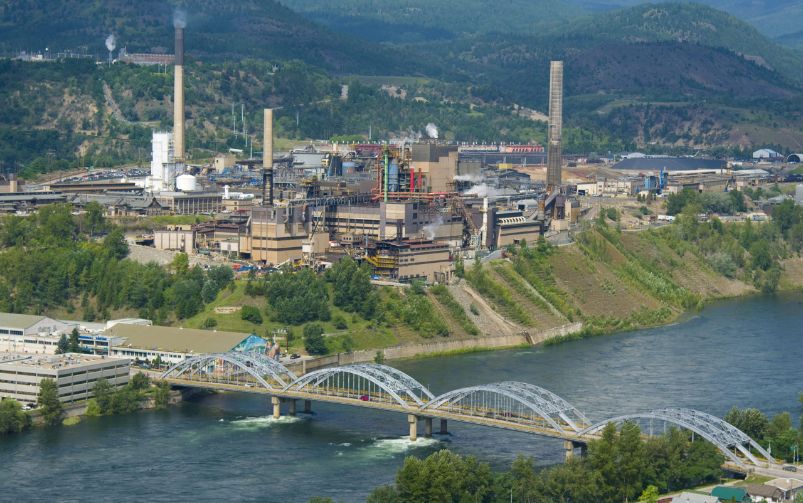Teck Resources reduced its Highland Valley Copper mine’s 2025 production guidance to 120,000 to 130,000 tonnes from 135,000 to 150,000 tonnes. Courtesy of Teck Resources
Welcome back to your weekly mining news recap, where we catch you up on some of the news you may have missed. This week’s headlines include Barrick selling its Tongon gold mine in Côte d’Ivoire, a Canadian mining tech start up signing a five-year partnership with Rio Tinto and the federal government opening funding for Indigenous projects linked to critical minerals mining.
Teck Resources has lowered its 2025 production guidance for copper to between 415,000 and 465,000 tonnes, down from earlier guidance of between 470,000 and 525,000 tonnes, following operational issues at its Quebrada Blanca mine in Chile and Highland Valley Copper (HVC) operation in Canada, The Canadian Press reported. The company also reduced HVC’s 2026 guidance due to lower ore grades and unplanned maintenance during this year’s third quarter.
At last week’s CIM Maintenance, Engineering and Reliability/Mine Operators (MEMO) Conference in Calgary, general session panellists discussed that while Canada’s mining sector is rich with opportunity, attracting and retaining skilled workers remains a major challenge. They called for stronger communication about mining careers with younger generations, expanded training programs and deeper Indigenous inclusion across the industry.
Barrick Mining will sell its Tongon gold mine and several exploration properties in Côte d’Ivoire to Atlantic Group for up to US$305 million, Mining Technology reported. The sale, expected to close in late 2025 pending approvals from the Côte d’Ivoire government, is part of Barrick’s strategy to focus on high-margin, long-life operations, particularly in copper and in key regions across Africa and the Middle East. The Tongon mine produced 148,000 ounces of gold in 2024.
The price of gold surged to record highs of more than US$4,000 an ounce this week as investors sought safe havens amid global geopolitical and economic uncertainty, Reuters reported. Silver also hit an all-time high of US$49.57 an ounce, surpassing its 1980 peak.
Seven workers that went missing last month after a mudslide at Freeport-McMoRan’s Grasberg copper mine in Indonesia were confirmed dead, The Northern Miner reported. The workers were conducting development activities on the mine’s service level when 800,000 tonnes of wet material swept through the site from the former Grasberg open pit. Operations have been suspended since September while Freeport and Indonesian authorities investigate the event, with findings expected by the end of 2025.
The Trump administration has ordered the approval of the 340-kilometre Ambler Road project in Alaska that will make the development of copper, cobalt, gold and other mineral resources easier in the region, The Associated Press reported. Initially approved under his first administration but later blocked by President Joe Biden over environmental concerns, the project has now been revived. The United States government is also paying US$35.6 million for a 10 per cent equity stake in the Canadian junior miner Trilogy Metals, which aims to develop a project in the Ambler region, pending regulatory approvals.
The federal government has launched a call for proposals for the Critical Minerals Infrastructure Fund (CMIF) Indigenous Grants stream, offering up to $3 million to support Indigenous participation in critical minerals projects, Canadian Mining Journal reported. Grants of up to $150,000 per project or up to $200,000 for northern or remote initiatives will prioritize proposals based on their potential to generate benefits for First Nations, Inuit and Métis, address project impacts and ensure equitable distribution across Indigenous groups.
Ideon Technologies has entered a five-year partnership with Rio Tinto to strengthen the miner’s supply of critical minerals using its subsurface intelligence platform, Reveal, International Mining reported. Under the agreement, Ideon will deploy Reveal across six of Rio Tinto’s largest global operations. Ideon co-founder Doug Schouten previously explained to CIM Magazine that the Reveal platform integrates data from multiple sources—including muon tomography, an imaging technique that uses naturally occurring cosmic ray muons to visualize geological structures deep underground—to provide a single, high-resolution, multi-dimensional model of the subsurface.
China has tightened export controls on rare earths and related materials critical for advanced tech manufacturing, Reuters reported. Under the new rules, foreign companies must obtain government approval to export products containing rare earths, components or assemblies with restricted magnets, or technologies for processing, recycling or manufacturing magnets. Export licences for defence users will be denied, while applications to export advanced semiconductors will be considered on a case-by-case basis.
Emerging artificial intelligence (AI) tools are reshaping how mines can unlock value and improve productivity at different stages of the mining cycle, Mehanaz Yakub reported for CIM Magazine. A new generation of companies and research institutions are using AI to discover new ore body deposits, optimize drilling parameters and simulate blast outcomes.
Wildfires have serious impacts on mine sites, making comprehensive mitigation planning essential for long-term resilience, Forsite Fire’s Andy Low told Mehanaz Yakub in a Q&A for CIM Magazine. Forsite Fire helps mining operations assess and reduce wildfire risks by combining on-site inspections with advanced modelling tools. The approach evaluates potential hazards and uses predictive models to help clients safeguard assets and maintain operational continuity.
That’s all for this week. If you’ve got feedback, you can always reach us at editor@cim.org. If you’ve got something to add, why not join the conversation on our Facebook, Twitter, LinkedIn or Instagram pages?




